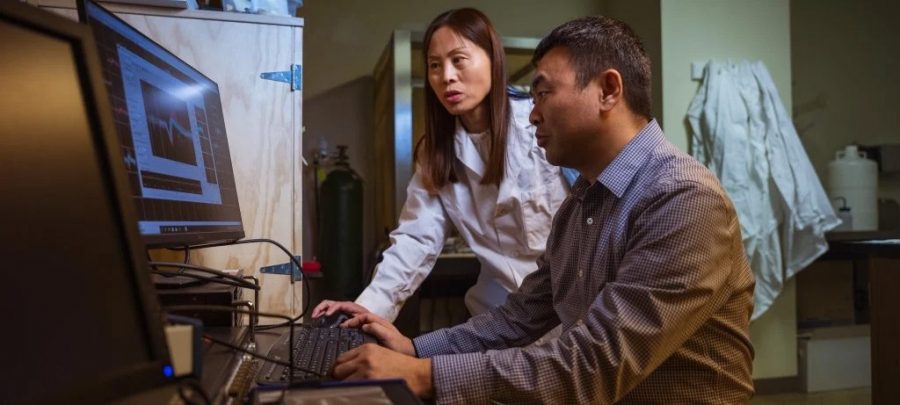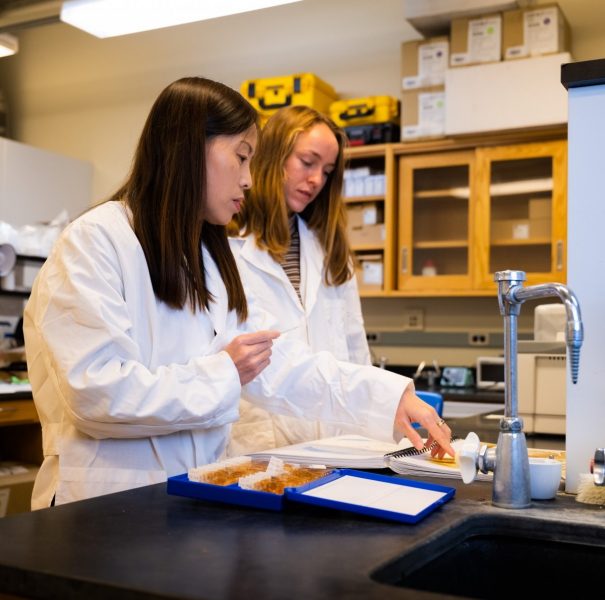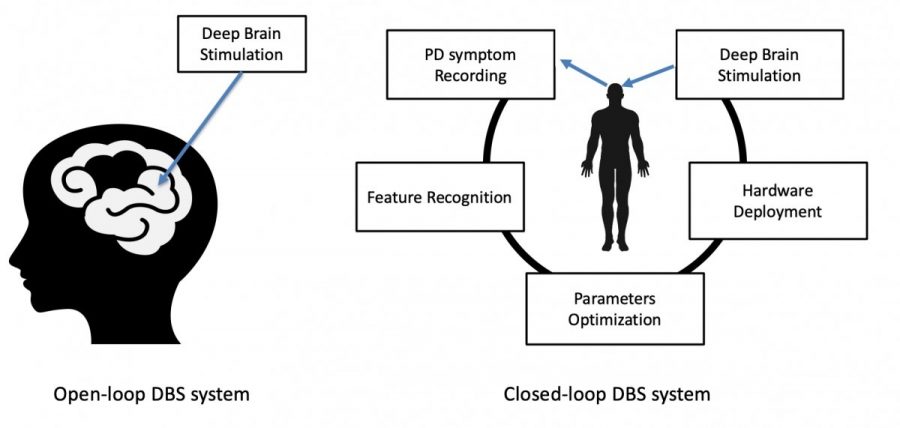
From Tech Magazine, Spring 2023. View the original article.
Researchers at Michigan Technological University are applying neuromorphic computing to improve the effectiveness and energy efficiency of deep brain stimulation systems used to treat Parkinson’s disease.
Currently incurable, Parkinson’s disease is a neurodegenerative disorder that affects millions worldwide. Deep brain stimulation (DBS) is an alternative to medications that are effective but lose effectiveness as patients develop drug resistance. Over time, larger doses of medication become necessary to control the condition and with them come potentially serious side effects. DBS is one alternative.
Making Deep Brain Stimulation Systems Better for Patients
DBS systems function like a pacemaker for the brain. They suppress the motor symptoms of Parkinson’s disease, including slowed or delayed movements (called bradykinesia), tremors and stiffness. An electrode, implanted into a specific target in the brain, emits electrical impulses using a battery-powered device in the chest.
DBS systems can be life-changing for people diagnosed with Parkinson’s disease. But battery life is a challenge. Current devices use an implantable pulse generator (IPG), surgically inserted in the chest or abdomen, to send stimulation signals to the brain at a constant frequency, regardless of the clinical state of the patient. Nonchargeable batteries last approximately two to five years. Battery replacement can be disruptive for patients; it requires a surgical procedure. And there can be unwanted side effects caused by the IPG’s continuous stimulation.

Chunxiu (Traci) Yu, an assistant professor of biomedical engineering, in collaboration with Hongyu An, an assistant professor of electrical and computer engineering, are working with their research teams to develop strategies using a different tool: neuromorphic computing.
Hongyu An is a member of the Institute of Computing and Cybersystems’s (ICC) Centers for Human-Centered Computing (HCC), Scalable Architectures and Systems (SAS), and Cyber-Physical Systems (CPS). Traci Yu is a member of the ICC’s Center for Biocomputing and Digital Health (BDH).
“Referred to as brain-inspired computing or neuroscience-powered artificial intelligence, neuromorphic computing emulates a nervous system using microchips and algorithms. It is also highly energy-efficient,” Yu said.
“Exploiting neuromorphic computing to improve deep brain stimulation for Parkinson’s disease is very innovative. To our knowledge, this is the first effort in the field.”Traci Yu, assistant professor of biomedical engineering
Closed-Loop Smart System Offers Intelligent Adjustments
In both Yu’s Brain Stimulation Engineering Lab in the Department of Biomedical Engineering, and An’s Brain-Inspired AI lab in the Department of Electrical and Computer Engineering research teams are developing strategies to improve DBS systems.
The collaborative project is focused on a closed-loop DBS system that can intelligently adjust stimulus signals according to patient symptoms.
“Most current DBS systems are open-loop. The open-loop DBS is on 24 hours a day, 365 days a year,” said Yu. Open-loop systems are high in energy consumption, providing continuous stimulation to the brain because the real-time symptoms are unknown to the device. “Using a closed-loop system allows us to optimize the energy-efficiency of DBS devices,” Yu explained. “The patient’s brain signals are used to generate a treatment signal — a stimulation — as needed, in real time.”
Using Spiking Neural Networks to Detect Symptoms
The cornerstone of Yu and An’s closed-loop DBS are spiking neural networks, or SNNs, a type of artificial neural network. SNNs can detect Parkinson’s symptoms and generate optimized electric stimulus pulses.
“The communication signals within SNNs are represented with small spike electrical pulses, in volts,” An explained. “In digital systems, data is represented by high and low voltages. For example, a high voltage represents logic one and a low voltage level represents logic zero. In this way, digital systems encode data in binary numbers.”
Data in SNNs can be carried in time, such as the interval between spikes, according to An. “As a result of this, SNN systems have much higher energy-efficiency compared to other artificial neural networks,” he said.
The researchers’ new closed-loop DBS system is able to evaluate the severity of Parkinson’s symptoms by measuring neural activity at a specific brain wave, or oscillation, bandwidth. The areas of the brain that control movement generate beta oscillations.
“We use the beta oscillatory activity as a biomarker because it can be detected much faster than other means, such as tremor signals,” An said. “If the neural activity detected is unusually strong, it indicates the Parkinson’s disease symptoms are more severe.”
SNNs in An’s lab operate using one of the most advanced neuromorphic chips around: Intel Loihi. In a collaboration with Intel, the lab is actively exploring ways to use the chip’s ultra-efficient intelligence to help patients with Parkinson’s disease.
“We’ve discovered that neuromorphic chips, including Intel Loihi, outperform other computational platforms in terms of energy-efficiency by 109 times,” An said.

Another innovation: An and Yu replaced the SNN’s traditional electronic memory with a memristor: an electrical component used in next-generation computers and electronics. A memristor can both store information like a memory chip and resist the flow of electric current, like a resistor in an electrical circuit.
A memristor looks like a resistor. The difference is that its resistance is changeable. “With carefully designed signals, the resistance of a memristor can be changed into multiple or even thousands of different resistances. This feature significantly increases the amount of information that can be stored by individual memristors,” said An.
In simulations, DBS systems using memristors led to smaller chips, faster transmission signals and less energy use.
“This result is highly promising,” An said.
Communicating Their Research

An, Yu and graduate researcher Zachary Kerman, a 2021 graduate who earned his bachelor’s in electrical and computer engineering at Michigan Tech, published a paper on their research for IEEE, at the 23rd International Symposium on Quality Electronic Design (ISQED): “Beta Oscillation Detector Design for Closed-Loop Deep Brain Stimulation of Parkinson’s Disease with Memristive Spiking Neural Networks.”
Designing a Customized DBS Chip is the Next Step
An and Yu plan to collaboratively design their own memristive neuromorphic chip specifically for closed-loop DBS systems.
“Our research on these new, innovative computational paradigms — along with the design of emergent AI chips — will open a new door to greater and faster development of smart medical devices for brain rehabilitation,” said An. “Even wearable medical devices are now well within the realm of possibility.”
For their students at Michigan Tech, the ongoing joint research provides the kind of unique learning experience that comes with working on the cutting edge of chip design, AI, neuromorphic computing and brain-computer interface.
“The chance to discover new deep brain stimulation technologies that could help people suffering from neurological conditions in the future keeps me driven to continue working in the lab and help the advancement of knowledge in this area,” said Jacob Jackson ’23, a biomedical engineering major who conducts research in Yu’s lab. He plans to begin his graduate work at Michigan Tech in the fall. “I am enjoying neural engineering research so much that I knew it was the right path for me,” he said.
Michigan Technological University is a public research university founded in 1885 in Houghton, Michigan, and is home to more than 7,000 students from 55 countries around the world. Consistently ranked among the best universities in the country for return on investment, Michigan’s flagship technological university offers more than 120 undergraduate and graduate degree programs in science and technology, engineering, computing, forestry, business and economics, health professions, humanities, mathematics, social sciences, and the arts. The rural campus is situated just miles from Lake Superior in Michigan’s Upper Peninsula, offering year-round opportunities for outdoor adventure.